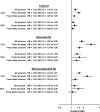Association of meat and fat intake with liver disease and hepatocellular carcinoma in the NIH-AARP cohort
- PMID: 20729477
- PMCID: PMC2935477
- DOI: 10.1093/jnci/djq301
Association of meat and fat intake with liver disease and hepatocellular carcinoma in the NIH-AARP cohort
Abstract
Background: Several plausible mechanisms, including fat, iron, heterocyclic amines, and N-nitroso compounds, link meat intake with chronic liver disease (CLD) and hepatocellular carcinoma (HCC). Few studies have investigated these associations.
Methods: We prospectively examined the relationship between meat and associated exposures with CLD mortality (n = 551; not including HCC) and HCC incidence (n = 338) in 495 006 men and women of the National Institutes of Health-AARP Diet and Health Study. Hazard ratios (HRs) and 95% confidence intervals (CIs) for the fifth (Q5) vs the first (Q1) quintile were estimated from multivariable adjusted Cox proportional hazards regression models. All tests of statistical significance were two-sided.
Results: We found inverse associations between white meat and risk of CLD (HR = 0.52, 95% CI = 0.39 to 0.70, 7.5 vs 18.2 cases per 100 000 person-years) and HCC (HR = 0.52, 95% CI = 0.36 to 0.77, 5.8 vs 14.3 cases per 100 000 person-years). Red meat was associated with higher risk of CLD (HR = 2.59, 95% CI = 1.86 to 3.61, 22.3 vs 6.2 cases per 100 000 person-years) and HCC (HR = 1.74, 95% CI = 1.16 to 2.61, 14.9 vs 5.7 cases per 100 000 person-years). Among fat types, results were strongest for saturated fat (for CLD, HR = 3.50, 95% CI = 2.48 to 4.96, 23.0 vs 6.5 cases per 100 000 person-years; for HCC, HR = 1.87, 95% CI = 1.23 to 2.85, 14.5 vs 6.3 cases per 100 000 person-years). After mutual adjustment, risk estimates persisted for saturated fat, red meat, and white meat. Heme iron, processed meat, nitrate, and nitrite were positively associated with CLD but not with HCC. Individual heterocyclic amines, 2-amino-3,4,8-trimethylimidazo[4,5,-f]quinoxaline (DiMeIQx), 2-amino-3,8-dimethylimidazo[4,5-f] quinoxaline (MeIQx), and 2-amino-1-methyl-6-phenyl-imidazo[4,5-b]pyridine (PhIP), were not associated with either outcome.
Conclusion: Our results suggest that red meat and saturated fat may be associated with increased CLD and HCC risk, whereas white meat may be associated with reduced risk.
Figures

Comment in
-
Re: Association of meat and fat intake with liver disease and hepatocellular carcinoma in the NIH-AARP cohort.J Natl Cancer Inst. 2011 Mar 2;103(5):446-8. doi: 10.1093/jnci/djq560. Epub 2011 Feb 2. J Natl Cancer Inst. 2011. PMID: 21289300 No abstract available.
Similar articles
-
Dietary fatty acids and pancreatic cancer in the NIH-AARP diet and health study.J Natl Cancer Inst. 2009 Jul 15;101(14):1001-11. doi: 10.1093/jnci/djp168. Epub 2009 Jun 26. J Natl Cancer Inst. 2009. PMID: 19561318 Free PMC article.
-
Index-based dietary patterns and risk of incident hepatocellular carcinoma and mortality from chronic liver disease in a prospective study.Hepatology. 2014 Aug;60(2):588-97. doi: 10.1002/hep.27160. Epub 2014 May 20. Hepatology. 2014. PMID: 24715615 Free PMC article.
-
Meat intake and risk of hepatocellular carcinoma in two large US prospective cohorts of women and men.Int J Epidemiol. 2019 Dec 1;48(6):1863-1871. doi: 10.1093/ije/dyz146. Int J Epidemiol. 2019. PMID: 31302687 Free PMC article.
-
Comparison of models to predict incident chronic liver disease: a systematic review and external validation in Chinese adults.BMC Med. 2024 Dec 31;22(1):601. doi: 10.1186/s12916-024-03754-9. BMC Med. 2024. PMID: 39736748 Free PMC article.
-
Liver diseases and hepatocellular carcinoma in the Asia-Pacific region: burden, trends, challenges and future directions.Nat Rev Gastroenterol Hepatol. 2024 Dec;21(12):834-851. doi: 10.1038/s41575-024-00967-4. Epub 2024 Aug 15. Nat Rev Gastroenterol Hepatol. 2024. PMID: 39147893 Review.
Cited by
-
Dietary patterns and hepatocellular carcinoma risk: a systematic review and meta-analysis of cohort and case-control studies.Nutr Metab (Lond). 2024 Jul 11;21(1):47. doi: 10.1186/s12986-024-00822-y. Nutr Metab (Lond). 2024. PMID: 38992637 Free PMC article. Review.
-
Association between Different Animal Protein Sources and Liver Status in Obese Subjects with Non-Alcoholic Fatty Liver Disease: Fatty Liver in Obesity (FLiO) Study.Nutrients. 2019 Oct 3;11(10):2359. doi: 10.3390/nu11102359. Nutrients. 2019. PMID: 31623368 Free PMC article.
-
CD36 genetic variation, fat intake and liver fibrosis in chronic hepatitis C virus infection.World J Hepatol. 2016 Sep 8;8(25):1067-74. doi: 10.4254/wjh.v8.i25.1067. World J Hepatol. 2016. PMID: 27660673 Free PMC article.
-
Association of meat consumption with NAFLD risk and liver-related biochemical indexes in older Chinese: a cross-sectional study.BMC Gastroenterol. 2021 May 17;21(1):221. doi: 10.1186/s12876-021-01688-7. BMC Gastroenterol. 2021. PMID: 34001005 Free PMC article.
-
Development of quantitative index evaluating anticancer or carcinogenic potential of diet: the anti-cancer food scoring system 1.0.Nutr Res Pract. 2018 Feb;12(1):52-60. doi: 10.4162/nrp.2018.12.1.52. Epub 2018 Jan 22. Nutr Res Pract. 2018. PMID: 29399297 Free PMC article.
References
-
- Parkin DM, Bray F, Ferlay J, Pisani P. Global cancer statistics, 2002. CA Cancer J Clin. 2005;55(2):74–108. - PubMed
-
- Yu MC, Yuan JM. Environmental factors and risk for hepatocellular carcinoma. Gastroenterology. 2004;127(5) suppl 1:S72–S78. - PubMed
-
- El-Serag HB, Rudolph KL. Hepatocellular carcinoma: epidemiology and molecular carcinogenesis. Gastroenterology. 2007;132(7):2557–2576. - PubMed
-
- Davila JA, Morgan RO, Shaib Y, McGlynn KA, El-Serag HB. Hepatitis C infection and the increasing incidence of hepatocellular carcinoma: a population-based study. Gastroenterology. 2004;127(5):1372–1380. - PubMed
-
- Di Bisceglie AM, Lyra AC, Schwartz M, et al. Hepatitis C-related hepatocellular carcinoma in the United States: influence of ethnic status. Am J Gastroenterol. 2003;98(9):2060–2063. - PubMed
Publication types
MeSH terms
Substances
Grants and funding
LinkOut - more resources
Full Text Sources
Medical
Miscellaneous

